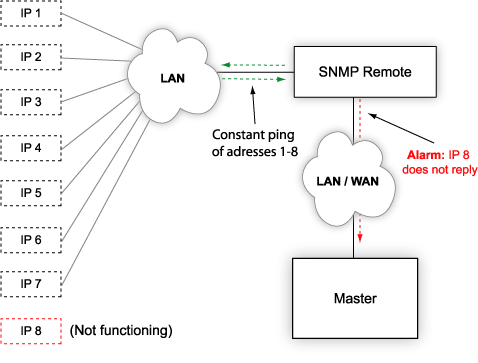Download our free SNMP White Paper. Featuring SNMP Expert Marshall DenHartog.
This guidebook has been created to give you the information you need to successfully implement SNMP-based alarm monitoring in your network.
1-800-693-0351
Have a specific question? Ask our team of expert engineers and get a specific answer!
Sign up for the next DPS Factory Training!

Whether you're new to our equipment or you've used it for years, DPS factory training is the best way to get more from your monitoring.
Reserve Your Seat Today Solutions for SNMP Remote Monitoring.
Over the years, I've learned a few things about making SNMP remote monitoring more effective.
First, there's the transition to SNMP. If you're running an older non-SNMP remote monitoring system, you might be put off by the high cost. Perhaps it's not the total dollar amount that's upsetting, but rather the idea that you must replace the entire system all at once (or run two systems side-by-side).

That's where the T/Mon master station can be helpful. T/Mon reads SNMP alarms like any standard SNMP manager, but it's also compatible with over 25 legacy and proprietary protocols. This multi-protocol asset provides a way to gradually switch toward SNMP monitoring - instead of a big budget outlay all at once.
Even if you already have a different SNMP manager in place, T/Mon can be used to bring non-SNMP gear under your SNMP umbrella. Devices that output ASCII text alerts (including TL1 gear like SONET devices), legacy and proprietary protocols, and many other alert types can be quickly mediated to SNMP, then sent to your SNMP manager. This gets rid of redundant monitoring systems and makes it easy for the staff you have to do the job of remote monitoring.
In a reverse of this SNMP mediation, T/Mon is also capable of mediating alarms from SNMP to another protocol. If you have some modern SNMP gear in your network, but you're happy with the main master you are using now, you can use T/Mon to collect SNMP alarms from your gear and send them to your TL1, Modbus, DNP3, or other master.
Then, after you have an SNMP manager in place, NetGuardian SNMP remotes can be used to convert contact closures to SNMP trap messages. Analog values like temp can also be converted to SNMP and sent back to the SNMP manager.
Several NetGuardian models are also capable of sending SNMP traps in SNMPv3 format. This allows you to encrypt your SNMP trap messages, which is valuable if you're part of a security-conscious company like a utility or government. While SNMPv3 is great, any alarm remote that you select should also support SNMPv1 or SNMPv2c. This is important if you find yourself working with an SNMP manager that only supports older versions of SNMP. This is the reason why all SNMPv3 NetGuardians also have support for SNMPv1 and SNMPv2c. Compared to SNMPv3, v1 and v2c don't require much processing power, so it made sense to include them as well.

Returning for a moment to SNMP managers, you need to make sure that any SNMP manager you choose for a telecom or IT management environment is able to display a "standing alarm" screen. This is different from merely displaying the SNMP traps that have been received. Smart SNMP managers actually tie in received "clear" trap messages with the original alarm a message. With this info, your SNMP manager will display only the alarm points (OIDs) that are still in a state of alarm. This reduces the amount of items your staff will have from unimportant alarms present on their SNMP manager screens.
How SNMP Remote Monitoring is Done in Real Networks.
One DPS client named Andrew came to DPS looking for the following things in an SNMP remote: First, he needed a 10/100 Ethernet interface port. This was needed to make sure that all alarms reached the SNMP manager quickly. Andrew also required 16 discrete contact closure inputs, eight analog inputs to support analog measurements like temperature, and two discrete control relays to remotely operate gear at the site. Control relays are useful for using gear like backup generators and HVAC systems.
Andrew also needed his SNMP remote to support temperature and battery monitoring, as well as a web interface for monitoring the device in a standalone mode without requiring an SNMP manager. The device had to be mountable in a single rack unit of a standard 19" rack, and it needed to accept 120 VAC power.
The right SNMP remote monitoring solution for Andrew turned out to be the NetGuardian 420. He spoke highly of the web-browser editing and provisioning and the outbound SNMP (only v1/v2c was required for his project). The NetGuardian 420 can also support SNMPv3. If Andrew was to shift to an SNMPv3 remote monitoring system in the future, his NetGuardians would be ready to make the shift without requiring any extra buying.
Another DPS client named Mitch came to DPS with a need to monitor 2 SONET rings via TL1 and some extra SNMP devices. He would need 20 RTUs to monitor battery voltage and the pressure of copper wires at each site. Mitch had 45 nodes on his SONET network, plus many channel banks that output SNMP traps. In total, he wanted to monitor 150 remote devices.
Mitch didn't want to monitor single battery cells. He just needed to know the thresholds of overall battery voltage. His need for copper pressure monitoring stemmed from the pressurized lines he had that hold copper for his phone lines. Any drop in pressure would indicate that a line had been cut, either as an accident or (more likely) from copper theft.
Mitch received an online web demo of T/Mon LNX and a few NetGuardian SNMP RTU models to help him in his decision. This was a big choice for Mitch, since this SNMP remote monitoring setup would be used by at least six users, and likely more.